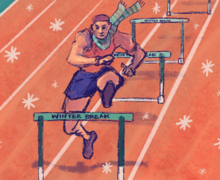3 takeaways from Syracuse’s 31-14 season-ending loss to No. 20 Pittsburgh
Max Mimaroglu | Staff Photographer
Garrett Shrader recorded a passing touchdown on Syracuse's opening drive, but its offense struggled afterwards.
Get the latest Syracuse news delivered right to your inbox.
Subscribe to our sports newsletter here.
With bowl eligibility on the line, Syracuse scored on the opening drive of the game against Pittsburgh, getting on the board before its opponent for the first time since its 24-21 win over Liberty over two months ago. But delivering the opening strike against the Panthers wasn’t enough on Saturday night as the Orange’s bowl dreams diminished along with their success on offense and defense.
Against Pittsburgh, who Syracuse head coach Dino Babers called its “natural rival,” the Orange earned just two first downs by the end of the first half after going up 7-0. The defense also caved following stops on three straight drives, allowing four touchdowns by the end of the night.
Along with the rest of the offense, Sean Tucker struggled as well, only recording 29 yards after breaking SU’s all-time single-season rushing record last week. Linebacker Mikel Jones finished with 17 tackles and Duce Chestnut made one interception, but more importantly, Pittsburgh quarterback Kenny Pickett picked apart the Orange’s defense for 209 passing yards, only getting sacked once.
Here are three takeaways from Syracuse’s 31-14 loss to Pittsburgh in its season finale:
Second-quarter collapse
After a scoreless first quarter last week against North Carolina State, the Orange allowed 28 points from the Wolfpack while only picking up seven on their own. The meltdown defensively was the eventual downfall for Syracuse as it was unable to bounce back in the second half, only scoring 10 points in the rest of the evening.
But Syracuse went into the second quarter with a 7-0 lead, a phenomenon unlike most games it has had all season. The problems against the Wolfpack, however, followed into its last game of the year as the collapse soon occurred.
The defense folded first, unable to stop Pitt’s high-flying pro-style offense or get any pressure on Pickett to make him throw on the run. The Panthers scored twice in the quarter — first on an 11-play drive and then on a deep bomb to Jordan Addison.
Then on offense, receiver Devaughn Cooper lost the ball, and quarterback Garrett Shrader was unable to escape pressure on four straight drives. The Panthers made Shrader drop back and pass, but with no receivers open he would move up into the pocket, allowing Pitt’s defensive line to easily get its hands on him. Babers said this issue was something the Orange had to fix going into Saturday’s game but that the problem is with blocking and not Shrader’s passing ability.
“There’s a guy missing a block, another guy missing a block, he’s scooting up in the pocket … avoiding sacks,” Babers said. “He doesn’t get to see the receiver pop open that’s really, really open.
By the end of the second quarter, Pittsburgh had a 14-7 lead. The Panthers were able to figure out what worked for them offensively (spread the ball out and force Syracuse’s unmatched safeties to make key plays) and defensively (stop Tucker and make Shrader pass).
Defensive up-and-downs
Pittsburgh entered the game as the Atlantic Coast Conference’s best offense, averaging 43.9 points per game. Pickett has been in the Heisman Trophy conversation for his role facilitating the Panthers’ dynamic offense. But early against Syracuse, Pittsburgh couldn’t find any success.
On Pitt’s first two drives, it was only able to get one first down. The Orange were able to find defensive success by keeping at least six or seven players in the box to stop the run, while also faking blitzes with Jones and Marlowe Wax on passing downs.
The Panthers also tried to get gains on bubble screens to the outside, but at cornerback Duce Chestnut was able to scope those plays out before the ball was thrown, making two tackles at the line of scrimmage in the first quarter. With a third-and-short on its third drive, Pittsburgh attempted a screen pass again, this time towards Garrett Williams. Like Chestnut, Williams saw the play from the snap, hopping out in front of a blocker to prevent the first down.
But Pittsburgh got into a rhythm, spreading out the field with deep passing concepts that forced some of Syracuse’s linebackers to drop into coverage. Pickett was able to find tight ends covered by the Orange’s linebackers twice for first downs, before finding running back Rodney Hammond Jr. wide-open on a screen pass for a touchdown. Pickett’s pass found Addison on the Panthers’ next drive on a deep bomb, lobbing the ball over Justin Barron for the score.
Syracuse’s defense took the field first in the second half, but its struggles carried over from the opening two quarters. This time, the Orange were unable to stop the run, allowing running back Vincent Davis to break five tackles and get inside the 30-yard line. Three plays later, Stefon Thompson sacked Pickett, but he was called for a facemask. Two plays later, Pickett found Gavin Bartholomew for a 4-yard touchdown.
The stops on screens that the Orange had earlier in the game started to disappear as well, coming with two passes to Addison — the first pass turned a third-and-2 into a 20-yard gain, and the second resulted in a touchdown. Both completions were successful because of Chestnut’s inability to get off a block, leaving Addison open to maneuver downfield.
Chestnut made up for his mistake by getting an interception in the end zone on Pittsburgh’s next drive, but he ran out to the 7-yard line instead of taking the touchback. The Orange finished the ensuing drive with a three-and-out, unable to score more than 14 points by the end of the game.
Third-and-long
In the Orange’s marquee fast-paced no huddle offense, they seek to get at least a couple of yards on each play to lessen the possibility of a third-and-long situation. On the year, Syracuse has a 33.3 % third-down conversion rate, a percentage that ranks 115th in the country.
But with a third-and-9 in the red zone against Pittsburgh on its first drive, the Orange converted. On the same play that resulted in a 17-yard game earlier in the series, Shrader found Courtney Jackson on a slant route to give the Orange the early lead.
Still, the Orange returned to their struggles with that distance on the next drive as Pittsburgh sent an all-out blitz at Shrader to force the ball out of his hands fast. While trying to find Tucker on a screen pass, the quarterback was wrestled to the ground by two Panthers defenders, as SU was forced to punt.
The same play happened on Syracuse’s next drive as left tackle Matthew Bergeron couldn’t pick up on a blitzer, leaving Shrader unable to do anything except fall to the ground in the backfield. The Orange were unable to pick up a first down by the end of the first half, going back into the locker room with a 28.5% third-down conversion rate.
At the start of the second half, the Orange started to improve on third down as Shrader found Oronde Gadsden II for the first down on third-and-6. The gain set up Syracuse’s offense to work into the red zone, ending a 79-yard drive with a touchdown pass to Jackson.
After Chestnut’s interception, the Orange were set up with a third-and-8 at the 7-yard line. But like most third-and-longs on Saturday night, the pressure was too much for Shrader. While he wasn’t taken down behind the line of scrimmage, Shrader was forced to roll out and throw the ball out of bounds as no receivers were open past the first down marker. The Orange only converted on two more first downs by the end of the game, unable to create big gains when they needed them the most.
Published on November 27, 2021 at 11:00 pm
Contact Anish: asvasude@syr.edu | @anish_vasu






